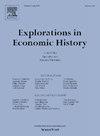动员母亲的人力:二战期间兰哈姆法案下的儿童保育
IF 1.7
1区 历史学
Q1 ECONOMICS
引用次数: 0
摘要
兰哈姆法案是国会于1940年通过的一项联邦基础设施法案,最终用于资助二战期间职业妇女的学龄前和学龄儿童项目。直到今天,它仍然是美国历史上唯一一个(几乎)普及的、主要由联邦政府支持的儿童保育项目。我们利用该项目、战争合同和城市层面的就业信息,探讨了它在二战期间促进和增加母亲劳动力供应方面的作用。将《兰哈姆法案》的资金用于战时儿童保育项目最初是有争议的。然而,该计划最终为每个儿童的平均每日出勤提供了充足的资金,并提供了总体上高质量的护理。但起步晚,范围有限,总体上无法大幅增加妇女就业。在那些母亲参与率较高以及战时需求最大的地方,托儿设施得到了更多的资助。对所服务儿童的影响仍有待确定。本文章由计算机程序翻译,如有差异,请以英文原文为准。
Mobilizing the manpower of mothers: Childcare under the Lanham Act during WWII
The Lanham Act was a federal infrastructure bill passed by Congress in 1940 and eventually used to fund programs for the preschool and school-aged children of working women during WWII. It remains, to this day, the only example in US history of an (almost) universal, largely federally supported childcare program. We explore its role in enabling and increasing the labor supply of mothers during WWII using information on the program, war contracts, and employment at the city level. Use of Lanham Act funds for a wartime childcare program was initially controversial. However, the program was eventually well funded per child in average daily attendance and provided generally high-quality care. But it was late to start, limited in scope, and incapable of greatly increasing women’s employment in the aggregate. Childcare facilities were funded more in places that already had higher participation rates of mothers and where the wartime need was the greatest. The impact on the children served is still to be determined.
求助全文
通过发布文献求助,成功后即可免费获取论文全文。
去求助
来源期刊

Explorations in Economic History
Multiple-
CiteScore
2.50
自引率
8.70%
发文量
27
期刊介绍:
Explorations in Economic History provides broad coverage of the application of economic analysis to historical episodes. The journal has a tradition of innovative applications of theory and quantitative techniques, and it explores all aspects of economic change, all historical periods, all geographical locations, and all political and social systems. The journal includes papers by economists, economic historians, demographers, geographers, and sociologists. Explorations in Economic History is the only journal where you will find "Essays in Exploration." This unique department alerts economic historians to the potential in a new area of research, surveying the recent literature and then identifying the most promising issues to pursue.
 求助内容:
求助内容: 应助结果提醒方式:
应助结果提醒方式:


